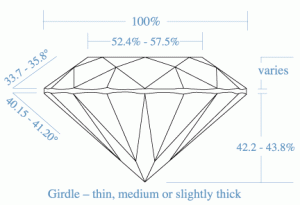Hi everyone.
Can anyone fill me in on what exactly ideal proportion means? I used to think that meant H&A, but thanks to all of you I know now they are two different things. When they say ideal proportions, are they referring to the table being between 58%-60% (not sure if these numbers are accurate) and depth perception being between xx and xx. If so, doesn''t the GIA certification rate these characteristics of the diamond.
Thanks
Can anyone fill me in on what exactly ideal proportion means? I used to think that meant H&A, but thanks to all of you I know now they are two different things. When they say ideal proportions, are they referring to the table being between 58%-60% (not sure if these numbers are accurate) and depth perception being between xx and xx. If so, doesn''t the GIA certification rate these characteristics of the diamond.
Thanks










300x240.png)